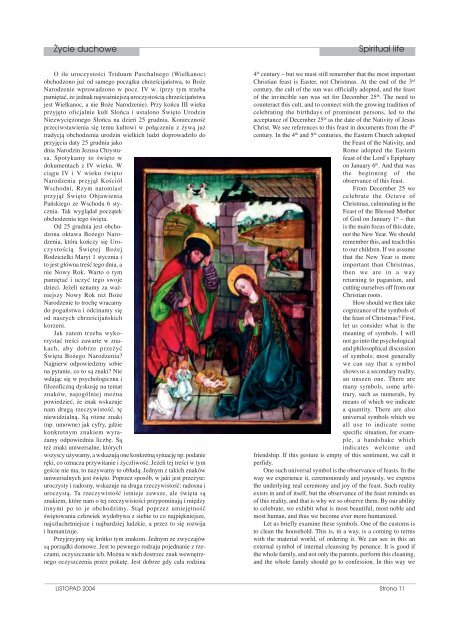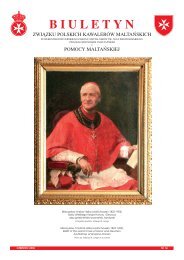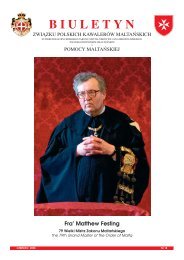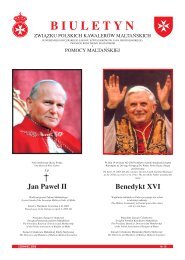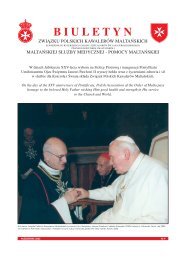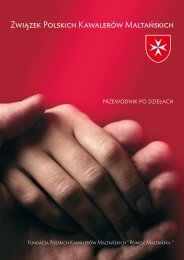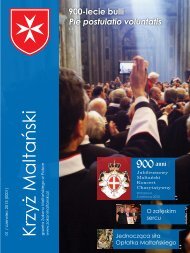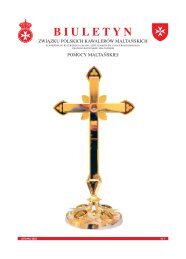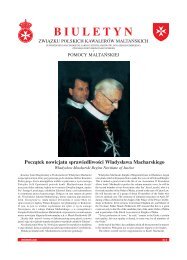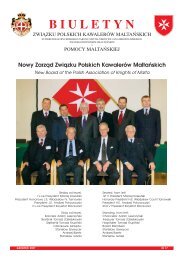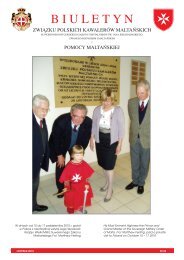HistoriaHistoryudało się zabrać; między pozostałymi w łóżkach chorymi Niem−cy ustawili granatniki i rozpoczęli ostrzeliwanie powstańców 4 .Pod eskortą Niemców pochód rannych pomaszerował przezPlac Bankowy, ul. Przechodnią, Plac Żelaznej Bramy, Ogród Saskido barykady blokującej ul. Marszałkowską. Po drodze tak cho−rzy, jak i lekarze byli zaczepiani przez Własowców, którzy za−bierali im cenne drobiazgi.Walki sprawiały, że Szpital musiał dość często zmieniać miej−sce działania. Ostatecznie, nocą z 5 na 6 września, zajął budynekprzy ul Śniadeckich 17 i tam funkcjonował aż do upadku Po−wstania. Po kapitulacji, jako jedyny szpital warszawski, Szpital<strong>Maltański</strong> został w całości ewakuowany do Piastowa i ulokowa−ny w fabryce „Tudor”.LIKWIDACJAPo zakończeniu wojny Szpital <strong>Maltański</strong> podlegał Polskie−mu Czerwonemu Krzyżowi i od dnia 23 marca 1945 roku działałjako pomocniczy szpital garnizonowy w Częstochowie. Wtedyteż przyjął nową nazwę „Szpital <strong>Maltański</strong> Czerwonego Krzy−ża”. W 1949 roku władze komunistyczne ostatecznie zlikwido−wały tę zasłużoną placówkę, a jej majątek i wyposażenie przeka−zały częstochowskiej służbie zdrowia.Pomimo likwidacji pamięć o Szpitalu <strong>Maltański</strong>m przetrwa−ła wśród mieszkańców Warszawy, byłych rannych niemieckichi polskiej emigracji. Magdalena Lipkowska wydała książkę o jegobohaterskiej epopei, a w 50−tą rocznicę jego powstania na daw−nym gmachu Resursy umieszczono pamiątkową tablicę z mal−tańskim krzyżem i prostym napisem „Tu działał wojskowy Szpi−tal <strong>Maltański</strong>”.Artykuł ten jest bardzo niepełnym i fragmentarycznym zary−sem dziejów Szpitala <strong>Maltański</strong>ego. Autor zadaje sobie z tegosprawę i przeprasza osoby których nazwiska, lub nazwiska ichbliskich, nie zostały wspomniane.1Maria Maciejewska Rucińska − Wojskowy Szpital <strong>Maltański</strong>. Szpital AK−s.l. s.a.2Ibidem, str. 223Odebrane rodzicom dzieci z terenów zamojszczyzny i ze względu na swój wyglądprzeznaczone do adopcji przez rodziny niemieckie i germanizacji.4dr J. Dreyza, Szpital <strong>Maltański</strong> przy ulicy Senatorskiej w czasie PowstaniaWarszawskiego [w:] Archiwum Historii Medycyny 1968, XXXI, 2, str. 265−70FINAL CLOSINGAfter the war, the Maltese Hospital came under the jurisdictionof the Polish Red Cross, and from March 23 rd 1945 it acted as theauxiliary military hospital in Częstochowa. At that time it adopteda new name, “Maltese Hospital of the Red Cross.” In 1949, theCommunist authorities finally abolished this heroic institution,transferring its assets and equipment to the public medical servicesof Częstochowa.Despite the abolishment, the memory of the Maltese Hospitalremained alive among the inhabitants of Warsaw, the formerGerman wounded, and the Polish émigré community abroad.Magdalena Lipkowska is writing a book about its heroic history,and on the 50 th anniversary of its establishment, a memorial plaquewas mounted on the Resursa building, carrying the Maltese Crossand a simple inscription: “Here stood the military MalteseHospital.”This article is a very incomplete and fragmentary outline ofthe history of the Maltese Hospital. The author realizes this, andbegs the forgiveness of persons whose names, or the names oftheir loved ones, were not mentioned.1Maria Maciejewska Rucińska, Wojskowy Szpital <strong>Maltański</strong>. Szpital AK. n.p.,n.d.2Ibid., pg. 223Action at the Arsenal, March 26, 1943, was an attack by AK units to rescue agroup of prisoners being moved by the Germans from Gestapo headquarters toPawiak prison. The action succeeded in freeing 21 of 25 prisoners.4SS General Franz Kutschera was a high Nazi official in occupied Warsaw, andchief of SS Police from October 1943. He was particularly barbaric, putting intoeffect mass executions which took the lives of about 4,300 persons. A court of thePolish Underground State issued a death sentence on him, and he was killed in araid by the AK on February 1, 1044. After his death, the Germans suspendedmass executions.5On August 12, 1943, a successful AK raid on a bank netted over 100 millionzlotys, intended to finance the operations of the AK Head Command.6A raid on September 26, 2943, on German police and military posts in the Wilanówsection of Warsaw, and on “Volksdeutch” collaborators (Polish residents of German descent who accepted German citizenship from the Nazis) in retaliation forinforming on AK units training in the nearby forests.7Children taken from their parents in the Zamość Region, intended because oftheir appearance for the “Liebensborn” program, i.e. Germanization throughadoption by German families.8Dr. J. Dreyza, “The Maltese Hospital on Senatorska Street during the WarsawUprising” in Archiwum Historii Medycny [Archives of history of medicine] 1968,XXXI, 2, p. 265−270Życie duchoweSpiritual lifeWIĘCEJ O ŚWIĘTACH BOŻEGO NARODZENIAMore About ChristmasKs. Mirosław NowosielskiŚwięto Bożego Narodzenia, które co roku obchodzimy,kojarzy nam się zwykle z choinką, wigilią, różnymi tradycjamirodzinnymi, dla rodziców zaś, a zwłaszcza dla kobiet – z trudamiprzygotowań do świąt. Tymczasem wiele cennych treści, jakieniosą te święta zostaje niezauważonych i nie wykorzystanychdla głębszego doświadczenia rozwoju duchowego. Są nimi znaki,jakie pojawiają się w Boże Narodzenie, a których treści rodzicemogą wykorzystać we wspaniałej „domowej” katechezie.W niniejszym artykule pragnę trochę pomóc rodzicom (i nietylko rodzicom), jak można lepiej przeżywać święta BożegoNarodzenia. Zacznijmy krótko od historii. Kiedy zaczętoobchodzić święta Bożego Narodzenia?The feast of Christmas, which we celebrate every year, weassociate with the Christmas tree, the Wigilia dinner, variousfamily traditions; for the parents, and especially for women, withthe hard work of preparing for the holidays. But much of thevaluable context of this feast remains unnoticed and unexploitedfor deeper spiritual development. There are symbols that can beseen at Christmas, which parents can use in religious educationin the home. In this article I aim to assist parents (and not onlyparents) in transmitting the message of Christmas.Let us start with some history. When was Christmas firstobserved? While the Easter Triduum was observed from the dawnof Christianity, Christmas was introduced at the beginning of theStrona 10 LISTOPAD 2004
Życie duchoweSpiritual lifeO ile uroczystości Triduum Paschalnego (Wielkanoc)obchodzono już od samego początku chrześcijaństwa, to BożeNarodzenie wprowadzono w pocz. IV w. (przy tym trzebapamiętać, że jednak najważniejszą uroczystością chrześcijaństwajest Wielkanoc, a nie Boże Narodzenie). Przy końcu III wiekuprzyjęto oficjalnie kult Słońca i ustalono Święto UrodzinNiezwyciężonego Słońca na dzień 25 grudnia. Koniecznośćprzeciwstawienia się temu kultowi w połączeniu z żywą jużtradycją obchodzenia urodzin wielkich ludzi doprowadziło doprzyjęcia daty 25 grudnia jakodnia Narodzin Jezusa Chrystu−sa. Spotykamy to święto wdokumentach z IV wieku. Wciągu IV i V wieku świętoNarodzenia przyjął KościółWschodni, Rzym natomiastprzyjął Święto ObjawieniaPańskiego ze Wschodu 6 sty−cznia. Tak wyglądał początekobchodzenia tego święta.Od 25 grudnia jest obcho−dzona oktawa Bożego Naro−dzenia, która kończy się Uro−czystością Świętej BożejRodzicielki Maryi 1 stycznia ito jest główna treść tego dnia, anie Nowy Rok. Warto o tympamiętać i uczyć tego swojedzieci. Jeżeli uznamy za waż−niejszy Nowy Rok niż BożeNarodzenie to trochę wracamydo pogaństwa i odcinamy sięod naszych chrześcijańskichkorzeni.Jak zatem trzeba wyko−rzystać treści zawarte w zna−kach, aby dobrze przeżyćŚwięta Bożego Narodzenia?Najpierw odpowiedzmy sobiena pytanie, co to są znaki? Niewdając się w psychologiczna ifilozoficzną dyskusję na tematznaków, najogólniej możnapowiedzieć, że znak wskazujenam drugą rzeczywistość, tęniewidzialną. Są różne znaki(np. umowne) jak cyfry, gdziekonkretnym znakiem wyra−żamy odpowiednia liczbę. Sąteż znaki uniwersalne, którychwszyscy używamy, a wskazują one konkretną sytuację np. podanieręki, co oznacza przywitanie i życzliwość. Jeżeli tej treści w tymgeście nie ma, to nazywamy to obłudą. Jednym z takich znakówuniwersalnych jest święto. Poprzez sposób, w jaki jest przeżyte:uroczysty i radosny, wskazuje na druga rzeczywistość: radosna iuroczystą. Ta rzeczywistość istnieje zawsze, ale święta sąznakiem, które nam o tej rzeczywistości przypominają i międzyinnymi po to je obchodzimy. Stąd poprzez umiejętnośćświętowania człowiek wydobywa z siebie to co najpiękniejsze,najszlachetniejsze i najbardziej ludzkie, a przez to się rozwijai humanizuje.Przyjrzyjmy się krótko tym znakom. Jednym ze zwyczajówsą porządki domowe. Jest to pewnego rodzaju pojednanie z rze−czami, oczyszczanie ich. Można w nich dostrzec znak wewnętrz−nego oczyszczenia przez pokutę. Jest dobrze gdy cała rodzina4 th century – but we must still remember that the most importantChristian feast is Easter, not Christmas. At the end of the 3 rdcentury, the cult of the sun was officially adopted, and the feastof the invincible sun was set for December 25 th . The need tocounteract this cult, and to connect with the growing tradition ofcelebrating the birthdays of prominent persons, led to theacceptance of December 25 th as the date of the Nativity of JesusChrist. We see references to this feast in documents from the 4 thcentury. In the 4 th and 5 th centuries, the Eastern Church adoptedthe Feast of the Nativity, andRome adopted the Easternfeast of the Lord’s Epiphanyon January 6 th . And that wasthe beginning of theobservance of this feast.From December 25 wecelebrate the Octave ofChristmas, culminating in theFeast of the Blessed Motherof God on January 1 st – thatis the main focus of this date,not the New Year. We shouldremember this, and teach thisto our children. If we assumethat the New Year is moreimportant than Christmas,then we are in a wayreturning to paganism, andcutting ourselves off from ourChristian roots.How should we then takecognizance of the symbols ofthe feast of Christmas? First,let us consider what is themeaning of symbols. I willnot go into the psychologicaland philosophical discussionof symbols; most generallywe can say that a symbolshows us a secondary reality,an unseen one. There aremany symbols, some arbi−trary, such as numerals, bymeans of which we indicatea quantity. There are alsouniversal symbols which weall use to indicate somespecific situation, for exam−ple, a handshake whichindicates welcome andfriendship. If this gesture is empty of this sentiment, we call itperfidy.One such universal symbol is the observance of feasts. In theway we experience it, ceremoniously and joyously, we expressthe underlying real ceremony and joy of the feast. Such realityexists in and of itself, but the observance of the feast reminds usof this reality, and that is why we so observe them. By our abilityto celebrate, we exhibit what is most beautiful, most noble andmost human, and thus we become ever more humanized.Let us briefly examine these symbols. One of the customs isto clean the household. This is, in a way, is a coming to termswith the material world, of ordering it. We can see in this anexternal symbol of internal cleansing by penance. It is good ifthe whole family, and not only the parents, perform this cleaning,and the whole family should go to confession. In this way weLISTOPAD 2004 Strona 11


